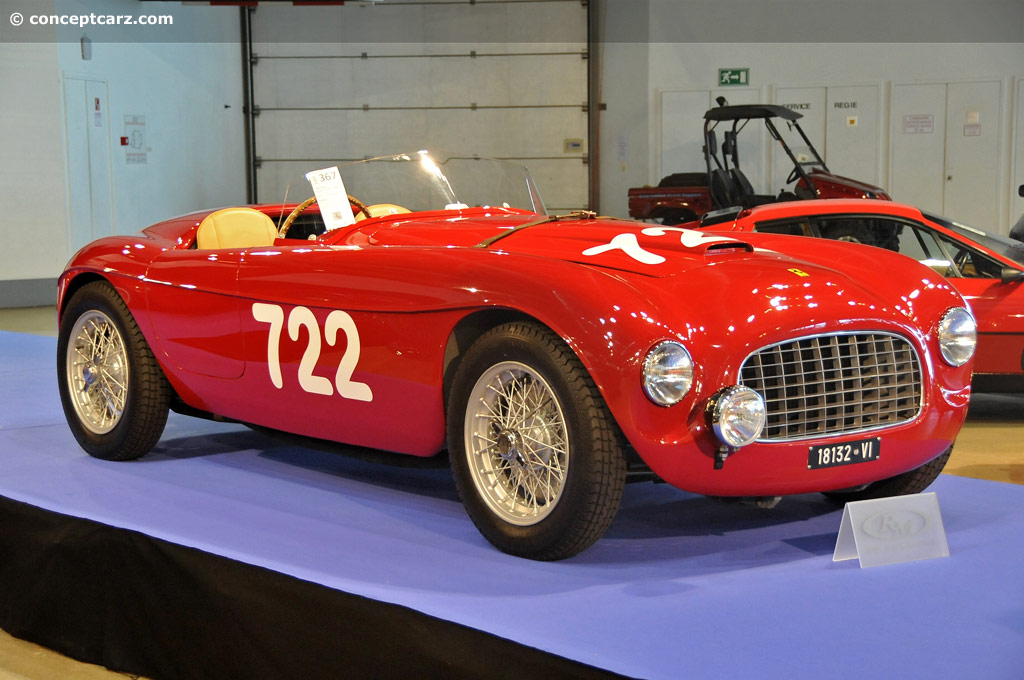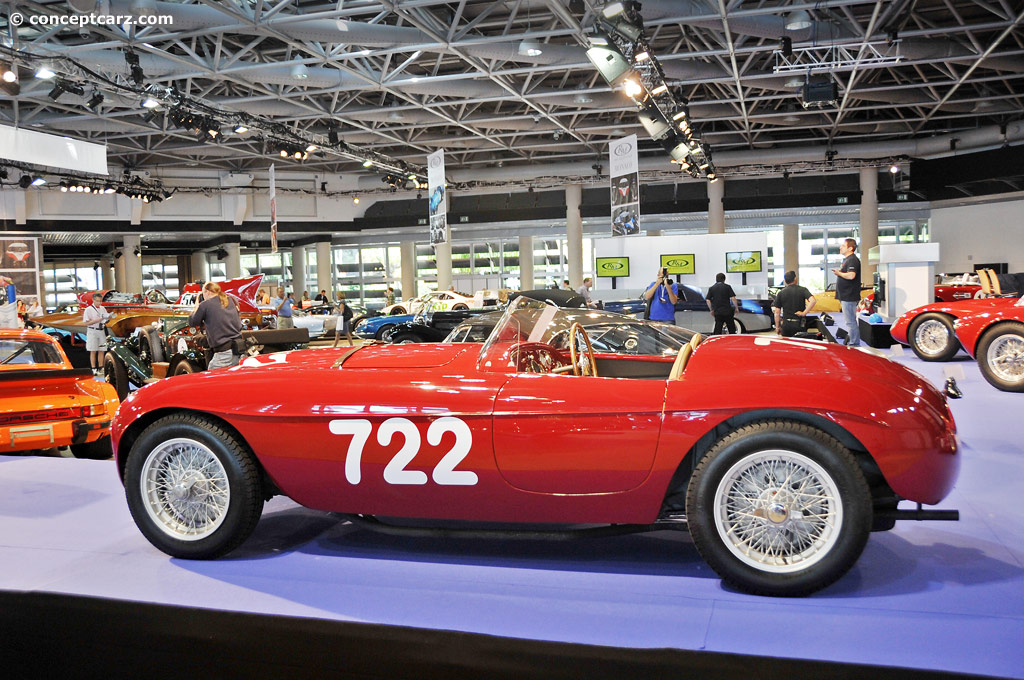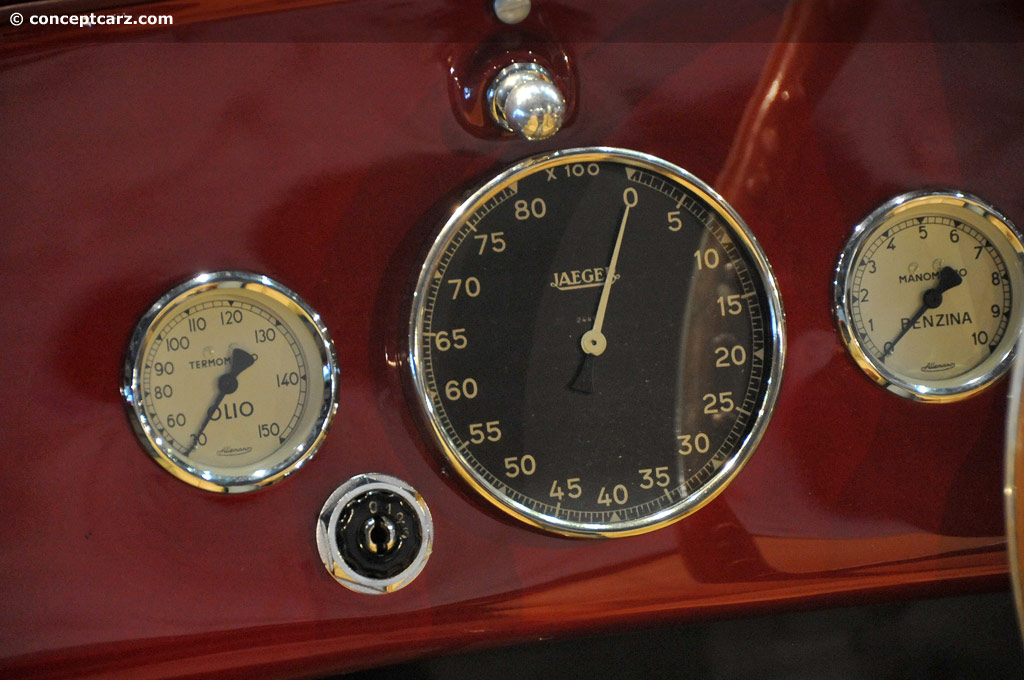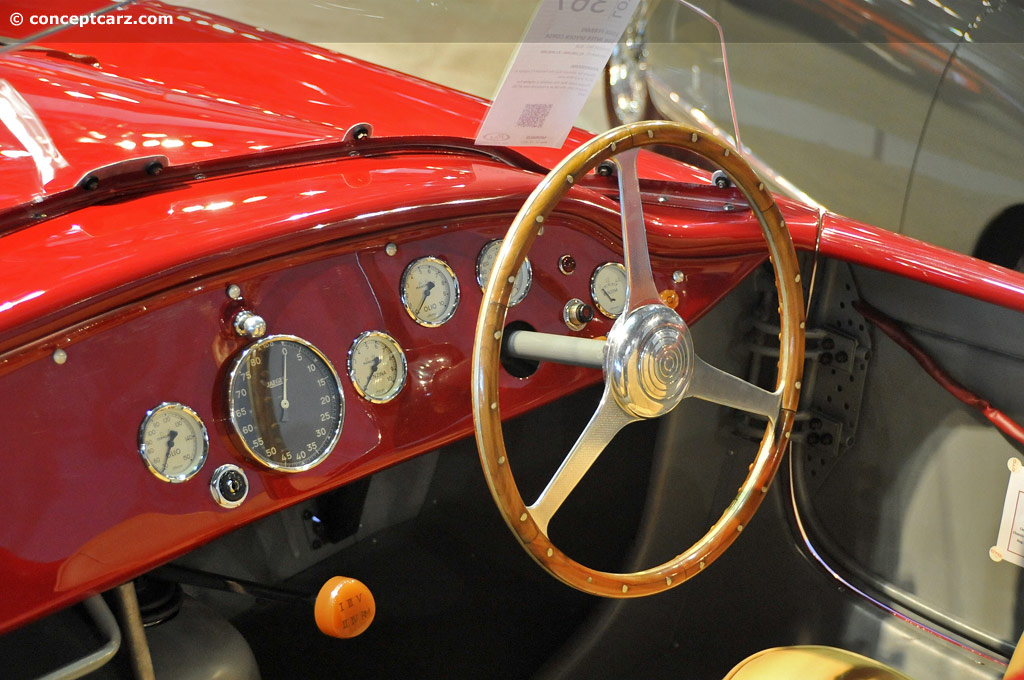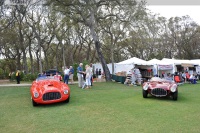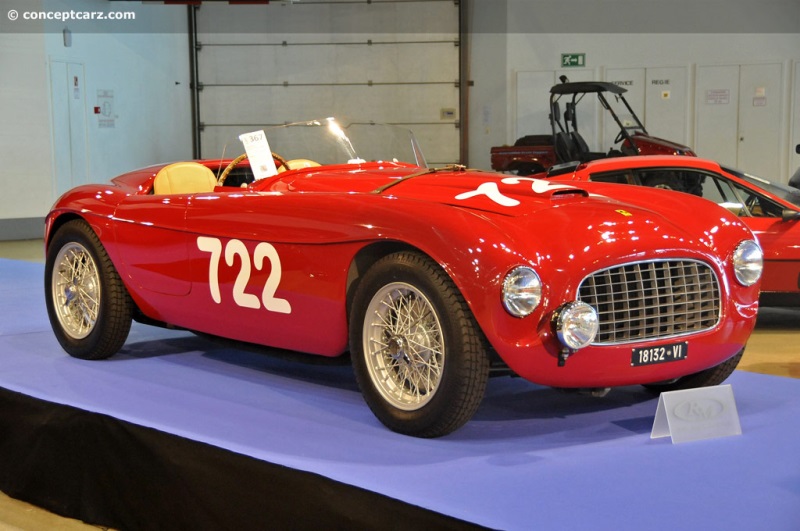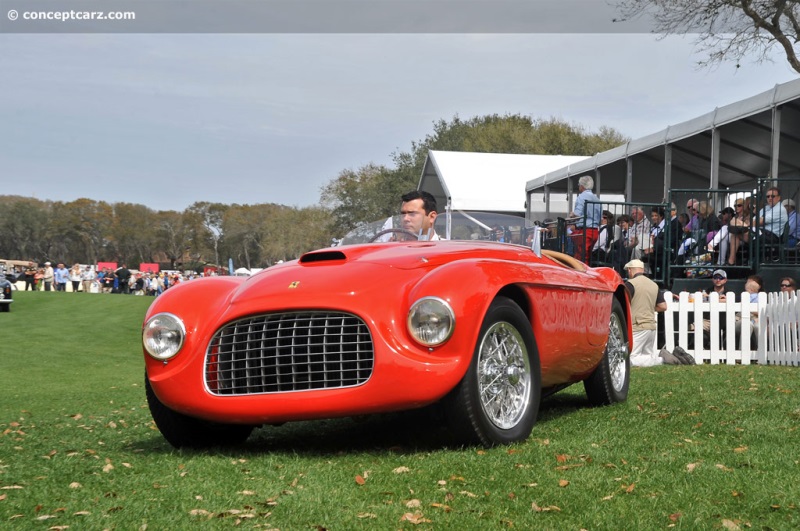Image credit: © conceptcarz.com (Reproduction Or reuse prohibited).
Chassis number 012I was the ninth Ferrari built, and the sixth of 166 (two-litre) Spyder Corsas. It began its life as a 166 Inter with a cycle-winged bodywork by Ansaloni. Completed in May, 1948, it just missed entry into the 1948 Mille Miglia, alongside its sister car, 010I, driven by Tazio Nuvolari. Its maiden outing was the Bari GP, piloted by Ferdinando Righetti. Next was the Jun Mantua, (Giampiero Bianchetti), then on to the Pescara GP, where Count Bruno Sterzi garnered the car's first podium trophy, finishing second overall. At the Coppa d'Oro delle Dolomiti, Sterzi finished ninth overall with co-pilot Enzo Monari. Around this time, it received its first engine transplant (believed to be 022I, now in the first Barchetta, 0002M).
The car's first ex-factory owner was Giovanni Bracco from Cossila, Italy who purchased the car in early 1949. Bracco drove the car in at least 13 different races in 1949 (sometimes co-piloted by Ferrari Grand Prix driver, Umberto Maglioli). Bracco and Maglioli's first race together was in the Giro di Sicilia, followed by entry into the Mille Miglia (24 April, 1949), with Bracco finishing sixth overall in the Grand Prix di San Remo in between.
At the conclusion of the 1949 season, Count Vittorio Emanuele Marzotto acquired Chiodo (as 012I had become known) from Bracco for a reputed one million lire, the first Ferrari to become part of Scuderia Marzotto, established by the five sons of textile mogul Gaetano Marzotto. The car was re-registered by its second owners, the Marzottos, with Vicenza plates 'VI 18132.'
While in the Marzottos care, the car was re-bodied as 'Spyder da Corsa Ferrari projecto Mille Miglia 1949', more commonly known as a Barchetta. The work was completed by Carrozzeria Fontana and has survived, remarkably intact, through the present day.
After the work was completed, the car was entered by Giannino Marzotto in the 1950 Targa Florio (On April 2nd of 1950), with co-pilot Marco Crosara. The duo would abandon the race to save the life of their friend and competitor, Fabrizio Serena.
At the Mille Miglia, the car was entered by Vittorio with the car's designer Paolo Fontana as the co-pilot. It wore the race number '722,' the official entry indicated Chiodo as a 'Type 195S Barchetta Fontana' (indicating what is presumed to be another engine upgrade, to 2.3 litres). At the conclusion of the race, the car had finished ninth overall, and Sixth in class.
Later, hill climb champion Bracco was enlisted at least once again, this time to drive the car at the Parma-Poggio de Berceto hill climb, where he again achieved first place overall. This appearance was followed by a hill climb entry by Vittorio Marzotto, where he also finished first overall at the Treponti-Castelnuovo event, sponsored by the Automobile Club di Padova.
At the close of 1950, more modifications were made to the coachwork, by Fontana for the 1951 season. It was given the addition of a fastback hardtop, along with the requisite 'Berlinetta' fixed windscreen, outside door handles and windscreen wipers, and now liveried in an apparent shade of silver.
It is believed that the car was raced in August of 1951 at the Giro di Calabria, driven by the Mancini brothers (#805), with 2,080 cc, finishing third overall. The next recorded event was the German Grenzlandring with driver Franco Comotti, who placed second overall in September, 1951. Next was the Grand Prix di Modena, where Ferrari Grand Prix champion Froilan Gonzalez (the 'Pampas Bull') placed Chiodo sixth overall for the Marzottos.
Chiodo began the 1952 season at the Gran Premio di Siracusa, again with Comotti at the wheel, and placed sixth overall. Comotti also drove it at the Grand Prix of France at Montlhery where it DNF'ed.
The car remained with Scuderia Marzotto until the team's liquidation in 1953. At that time, it was sold to Ferrari test driver Martino Severi, in a package with nine Ferraris, their transport truck and 'a mountain of parts'.
The last recorded competition entry for Chiodo was as a Targa Florio entrant in 1955, driven by Roman racer Francesco Matrullo, in his last known race. By this point the car's life, after having an eight-season racing career, it was no longer competitive. The car now had a shortened wheelbase, reduced by some 150 mm. This modification was perhaps made for its hill climbing endeavors, where a shorter wheelbase might have provided handling and performance advantages.
In 1970, the car was found in a dark garage in south Rome. The auxiliary hard top had been removed and it wore the Fontana body on the shortened original chassis. Corrado Cupellini purchased the car, along with a 166 engine from the 1950 Marzotto Formula 2 Ferrari, 116MS. It was given a light overhaul and then sold to Jacques Thuysbaert in 1972. Engine 116MS still remains in the car.
It was sold to Giuseppe Medeci of Reggio Emelia in the mid-1970s and given its first restoration, which was entrusted to Autofficina Piero Mazzetti in 1976. The work was completed in time for entry into the first Mille Miglia Storica event, held 17-19 June 1977. The car wore number 84 and was piloted by the owners, Medici & Medici. Sometime later in 1977, the car was sold back to Willy Felber, after which ownership was transferred to Jean Zanchi of Lausanne, Switzerland in 1978.
Zanchi campaigned the car in historic events in 1979, such as the Coupe de Lage d'Or at Montlhéry, Paris and the VII AVD-Oldtimer-Grand Prix at the Nürburgring in Germany, driven by Pierre De Siebenthal. It was raced one last time by Zanchi in the Grand Prix of Lausanne, after which it was given a 'proper' restoration, with the intent on replacing the 40 year-old metal. Thankfully, he did not get very far in the restoration process.
In the late 1990s, the current owner visited the small garage of Beppe Castagno, outside of Turin, to inspect the car. The California individual purchased the car mid-restoration, with the objective of saving the original body, chassis and the F2 engine. Castagno was initially commissioned to re-restore the car, but years later, with little progress made, the owner made the decision to collect the car and bring it to California to complete the work. By the mid-2000s, the car was in California.
Currently, the car wears a 1950 Barchetta body by Carrozzeria Fontana and is powered by a 2-liter overhead-camshaft V-12 engine offering nearly 200 horsepower. There is a four-speed manual gearbox and four-wheel hydraulic drum brakes.
In 2012, this car was offered for sale at the Monaco sale presented by RM Auctions. The car was estimated to sell for €1.100.000-€1.800.000. As bidding came to a close, the car had been sold for the sum of €1.010.000 inclusive of buyer's premium.By Daniel Vaughan | Jun 2012
The car's first ex-factory owner was Giovanni Bracco from Cossila, Italy who purchased the car in early 1949. Bracco drove the car in at least 13 different races in 1949 (sometimes co-piloted by Ferrari Grand Prix driver, Umberto Maglioli). Bracco and Maglioli's first race together was in the Giro di Sicilia, followed by entry into the Mille Miglia (24 April, 1949), with Bracco finishing sixth overall in the Grand Prix di San Remo in between.
At the conclusion of the 1949 season, Count Vittorio Emanuele Marzotto acquired Chiodo (as 012I had become known) from Bracco for a reputed one million lire, the first Ferrari to become part of Scuderia Marzotto, established by the five sons of textile mogul Gaetano Marzotto. The car was re-registered by its second owners, the Marzottos, with Vicenza plates 'VI 18132.'
While in the Marzottos care, the car was re-bodied as 'Spyder da Corsa Ferrari projecto Mille Miglia 1949', more commonly known as a Barchetta. The work was completed by Carrozzeria Fontana and has survived, remarkably intact, through the present day.
After the work was completed, the car was entered by Giannino Marzotto in the 1950 Targa Florio (On April 2nd of 1950), with co-pilot Marco Crosara. The duo would abandon the race to save the life of their friend and competitor, Fabrizio Serena.
At the Mille Miglia, the car was entered by Vittorio with the car's designer Paolo Fontana as the co-pilot. It wore the race number '722,' the official entry indicated Chiodo as a 'Type 195S Barchetta Fontana' (indicating what is presumed to be another engine upgrade, to 2.3 litres). At the conclusion of the race, the car had finished ninth overall, and Sixth in class.
Later, hill climb champion Bracco was enlisted at least once again, this time to drive the car at the Parma-Poggio de Berceto hill climb, where he again achieved first place overall. This appearance was followed by a hill climb entry by Vittorio Marzotto, where he also finished first overall at the Treponti-Castelnuovo event, sponsored by the Automobile Club di Padova.
At the close of 1950, more modifications were made to the coachwork, by Fontana for the 1951 season. It was given the addition of a fastback hardtop, along with the requisite 'Berlinetta' fixed windscreen, outside door handles and windscreen wipers, and now liveried in an apparent shade of silver.
It is believed that the car was raced in August of 1951 at the Giro di Calabria, driven by the Mancini brothers (#805), with 2,080 cc, finishing third overall. The next recorded event was the German Grenzlandring with driver Franco Comotti, who placed second overall in September, 1951. Next was the Grand Prix di Modena, where Ferrari Grand Prix champion Froilan Gonzalez (the 'Pampas Bull') placed Chiodo sixth overall for the Marzottos.
Chiodo began the 1952 season at the Gran Premio di Siracusa, again with Comotti at the wheel, and placed sixth overall. Comotti also drove it at the Grand Prix of France at Montlhery where it DNF'ed.
The car remained with Scuderia Marzotto until the team's liquidation in 1953. At that time, it was sold to Ferrari test driver Martino Severi, in a package with nine Ferraris, their transport truck and 'a mountain of parts'.
The last recorded competition entry for Chiodo was as a Targa Florio entrant in 1955, driven by Roman racer Francesco Matrullo, in his last known race. By this point the car's life, after having an eight-season racing career, it was no longer competitive. The car now had a shortened wheelbase, reduced by some 150 mm. This modification was perhaps made for its hill climbing endeavors, where a shorter wheelbase might have provided handling and performance advantages.
In 1970, the car was found in a dark garage in south Rome. The auxiliary hard top had been removed and it wore the Fontana body on the shortened original chassis. Corrado Cupellini purchased the car, along with a 166 engine from the 1950 Marzotto Formula 2 Ferrari, 116MS. It was given a light overhaul and then sold to Jacques Thuysbaert in 1972. Engine 116MS still remains in the car.
It was sold to Giuseppe Medeci of Reggio Emelia in the mid-1970s and given its first restoration, which was entrusted to Autofficina Piero Mazzetti in 1976. The work was completed in time for entry into the first Mille Miglia Storica event, held 17-19 June 1977. The car wore number 84 and was piloted by the owners, Medici & Medici. Sometime later in 1977, the car was sold back to Willy Felber, after which ownership was transferred to Jean Zanchi of Lausanne, Switzerland in 1978.
Zanchi campaigned the car in historic events in 1979, such as the Coupe de Lage d'Or at Montlhéry, Paris and the VII AVD-Oldtimer-Grand Prix at the Nürburgring in Germany, driven by Pierre De Siebenthal. It was raced one last time by Zanchi in the Grand Prix of Lausanne, after which it was given a 'proper' restoration, with the intent on replacing the 40 year-old metal. Thankfully, he did not get very far in the restoration process.
In the late 1990s, the current owner visited the small garage of Beppe Castagno, outside of Turin, to inspect the car. The California individual purchased the car mid-restoration, with the objective of saving the original body, chassis and the F2 engine. Castagno was initially commissioned to re-restore the car, but years later, with little progress made, the owner made the decision to collect the car and bring it to California to complete the work. By the mid-2000s, the car was in California.
Currently, the car wears a 1950 Barchetta body by Carrozzeria Fontana and is powered by a 2-liter overhead-camshaft V-12 engine offering nearly 200 horsepower. There is a four-speed manual gearbox and four-wheel hydraulic drum brakes.
In 2012, this car was offered for sale at the Monaco sale presented by RM Auctions. The car was estimated to sell for €1.100.000-€1.800.000. As bidding came to a close, the car had been sold for the sum of €1.010.000 inclusive of buyer's premium.By Daniel Vaughan | Jun 2012
Almost immediately after establishing the company sharing his last name, Enzo Ferrari and his team would produce a winning design. Giacchino Colombo would work hard to produce a versatile V12 engine that would lead to the 125. The 125, however, would be just the beginning. The 125 would evolve into the 166 S racing car and this chassis would go on to earn a number of important victories for Scuderia Inter. Realizing he had a successful car to produce and sell, Ferrari would determine to build the 166 Inter.
Named after the Scuderia Inter team that successfully campaigned the 166 S. The 166 would come from its engine size, which had been increased to 1.66-liters from the 1.5-liter engine that had been used in the 125. Developed from the 166 S race car, the 166 Inter would become Ferrari's first true grand tourer. It would be a sports car built for the street and would feature custom-built coach bodies.
Although the 166 Inter would not be introduced until the Paris Motor Show in October of 1949, the first edition of the 166 Inter would first be produced in 1948. And one of those early 166 Inters would be presented at RM Auctions' event in Monaco in 2012.
Chassis 012I, according to official records, is a truly special example in Ferrari's extensive history. Only the ninth Ferrari built according to the sequence in chassis construction. In addition, it would be just the sixth 166 Inter ever to be produced. But the example presented for auction would differ a fair bit from what it originally looked like leaving the Ferrari factory when it was completed in May of 1948.
When chassis 012I was finished by the coachbuilder Ansaloni the chassis would be finished with cycle-wings and would become one of the first to become known as 'Spyder Corsas'. When, the car was finished it would just miss out on an opportunity to take part in the 1948 Mille Miglia. Had the car taken part in the race it would have joined its sister-car in the event. Incidentally, the sister-car to 012I would be driven by the famous Tazio Nuvolari.
Still, 012I would see some racing action. Its first taste of motor racing would come at the hands of Ferdinando Righetti at the Bari Grand Prix. Later on, the car would take part in the Pescara Grand Prix. Driven by Count Bruno Sterzi, the car would go on to earn its first podium result finishing 2nd overall.
Some time later, 012I would take part in the Coppa d'Oro delle Dolomiti with Count Bruno Sterzi back at the wheel. The car would finish the event in 9th place overall. This would be a very impressive result for the car.
Victories would come later on in the car's first season. Giovanni Bracco would take the Ferrari and would compete in a few hill climbs. This would result in a victory at the Rocco di Papa Hill Climb. The victory would earn Bracco the Gallenga Cup.
Bracco, known as impatient young man, seemed to have found his car. The man from Cossila, Italy would end up purchasing 012I in early of 1949. Known for his famous motto, 'Either it goes or I crash it', Bracco would use his talent to road racing and would use 012I to enter no fewer than 13 races throughout the 1949 season. Bracco would campaign the temperamental Spyder Corsa along with co-driver Umberto Maglioli. Bracco would be most active taking part in hill climbs throughout Italy. As a result of his numerous participation and success in them, Bracco would become the 1949 Italian Hill Climb Champion.
After the 1949 season, Bracco would sell the 166 to the well-known Count Emanuele Marzotto for a price around one million lire. This would make 012I one of the first cars as part of the Scuderia Marzotto racing stable. While with the Marzottos, the car would be given Vicenza plates with the identification 'VI 18132'.
The Marzotto brothers were well-known for changing the bodies of the cars with great regularity and 012I would be no exception. The brothers would hire the services of Carrozzeria Fontana to take the car, as it existed at that moment, and would be transformed into what was termed 'Spyder da Corsa Ferrari projecto Mille Miglia 1949', meaning it would be transformed into a Barchetta. Fontana would transform the car into a Barchetta, or, 'little boat'.
While bearing similarity to the well-known Touring version, Fontana's example of the design would feature some appealing departures that would neatly demonstrate both the athletic and the elegant properties. It would include a longer rear end, a peaked full width windscreen and would give the car a much more aggressive look than the design of many of the 166 Inters designed throughout the later 1940s and early 1950s.
Soon after completion, Giannino Marzotto would enter 'Chiodo' (as given by Bracco meaning 'nail') in the 1950 Targa Florio. Marzotto's race would go well until there was a terrible accident involving Fabrizio Serena. A good friend of Marzotto, the accident would lead Marzotto and his co-driver Marco Crosara to abandon the race in an effort to help their friend. This tragic event would lead into 012I's most demonstrative performance.
Numbered '722' 012I would be entered as a Type 195S Barchetta Fontana in the 1950 Mille Miglia. Presumably having an upgraded 2.3-liter engine, 012I would finish the event in 9th place overall and would actually go on to beat every single one of the factory entered Ferraris in the race. This, as it would be noted, would absolutely frustrate and upset Enzo Ferrari. Many suggest this event, and this car's performance would spark the beginning of the love/hate relationship Ferrari had with the Marzotto brothers.
The remainder of the 1950 season would see that car achieve a couple more hill climb victories. Still, the Marzotto brothers would grow weary of the car's new design and would only want it to evolve again. Therefore, it would be sent back to Fontana at the end of the 1950 season for more coachwork. When it reemerged in early 1951, the car would feature the same basic coach-built body but it would now feature a fastback hardtop. The required 'Berlinetta' fixed windscreen would also be added to the car along with some other features like outside door handles, windscreen wipers and a silver livery.
Still, the car would be campaigned in races long after its apparent life-span had come and gone. The car would show the same determined attitude its owners had when it managed a 3rd place overall finish in the Giro di Calabria in August of 1951. The car would continue to impress with a 2nd place overall finish at the German Grenzlandring when it was driven by Franco Comotti. Then, in late September, the 166 Inter would be driven by none other than Ferrari's first Formula One race winner Jose Froilan Gonzalez. Gonzalez would drive the car in the Grand Prix di Modena and would place 6th overall.
012I would remain with Scuderia Marzotto until it ceased in 1953. At that time, the car would be sold, like the other chassis and the large amounts of spare parts. 012I would end up as the property of other brothers, the Mancini brother of Rome. Although well past its prime for motor racing, 012I would still be entered in races. Its last known event would be the Targa Florio in 1955 where it would be entered and driven by Francesco Matrullo. It is noted the car, at the time of the event, had an obvious shorter wheelbase.
From that last entry in the Targa Florio in 1955, 012I would live quietly until 1970 when it would resurface in a garage in the south of Rome. While the Fontana body remained intact, the car featured its auxiliary hard top removed and still with its shortened chassis. Ferrari aficionado Corrado Cupellini would make the find and would document its sad and dreary state when it was found. Still, Cupellini would acquire the car and would set about doing some restoration work just to get the car running again.
After finding a 166 engine from Marzotto's Formula 2 Ferrari, Cupellini would continue with some restoration work and would finally get it up to running condition whereupon it would be sold in 1972 to Jacques Thuysbaert.
Interestingly, a noted Ferrariste by the name of Jess G. Pourret, around 1975, would come looking at the car. He would be blinded expecting something else and would totally ignore and fail to realize the fact he had just seen only the ninth Ferrari chassis ever to leave the factory.
During that same year, the car would be sold to Giuseppe Medici of Reggio Emelia. This sale would prove providential as Medici would immediate embark upon having the car restored. It would be entrusted to Autofficina Piero Mazzetti in 1976.
For years 012I had taken part in the actual Mille Miglia races. When the car emerged from restoration in early 1977 it would be entirely roadworthy and finished in time to enter what was the first Mille Miglia Storica in June of 1977. Wearing number '84', the car would take part in what has since become one of the most highly profiled historic road races throughout the world.
In 1978, after a brief time with Willy Felber, the car would be sold to Jean Zanchi of Lausanne, Switzerland. Zanchi would let the car's racing heritage continue by taking part in a number of historic races, the first of which would be the Coupe de Lage d'Or at Montlhery. The car would also take part in the VII AvD-Oldtimer-Grand Prix at the Nurburgring in Germany. The final race for the car would be the Grand Prix of Lausanne. By that point in time most of the original sheetmetal bodywork had become worn and loosened. Therefore, it was necessary for the car to undergo a proper full restoration.
By the mid-1990s, 012I was still in the midst of being restored when it was discovered in a small garage outside of Turin, Italy by a Californian man. He would purchase the car almost on the spot and would set about completing the restoration efforts with the main focus being to save as much of the original body as possible. He had the goal of restoring the car to its former 1950 glory.
After a slow and frustrating period when Castagno had been commissioned to restore the car, the car would be shipped to California and work would begin restoring the car back to its original dimensions from the 1950 season. Patrick Ottis would be in charge of taking the ex-Scuderia Marzotto 166 F2 engine, that was still in the car. His task was to rebuild it until it was practically a fresh new engine. When he finished, the engine would be tested on a dyno and would produce more than 190 bhp. This would be an incredible amount of power for an engine of its size and in a car of its size.
The chassis and body would be delivered to Curtis Patience of Portland, Oregon. Patience had been part of Brian Hoyt's Perfect Reflections and certainly had the talent and experience for such a project. The entire process of the restoration would be documented in a 2011 issue of The Prancing Horse.
Finally, the car would be sent in its near final form to Phil Reilly & Co. of San Rafael, California. Ivan Zaremba would have the pleasure and the responsibility in doing the final sorting and testing of the completed chassis. This had the potential of being a real nerve-racking and testing experience in its own right but practically everyone would agree the final product would be inestimable in its quality and historic appeal.
With the final stages of the restoration only being completed in January of 2012, the RM Auctions event in Monaco in May would be 012I's first official outing since having completed its glorious restoration. Finished in Italian racing red with the famed '722' it wore in the 1950 Mille Miglia, this iconic and remarkably special 166 Inter would retain its 190 bhp, 2.0-liter engine and Fontana body. And with numerous victories on the track and in hill climbs, this striking 166 Inter Spyder Corsa, despite its compact size, has a rather influential place in Ferrari's early sports car racing history. Being just the sixth Spyder Corsa ever and having been driven by the likes of Giovanni Bracco, Umberto Maglioli, Vittorio Marzotto and Jose Froilan Gonzalez, 012I's place in automotive and motor racing history only becomes more impressive. This fact would be well represented when the car was sold at auction for 1,010,000 EUR.
Sources:
'Lot No. 367: 1948 Ferrari 166 Inter Spyder Corsa by Carrozzeria Fontana', (http://www.rmauctions.com/FeatureCars.cfm?SaleCode=MC12&CarID=r301). RM Auctions. http://www.rmauctions.com/FeatureCars.cfm?SaleCode=MC12&CarID=r301. Retrieved 15 May 2012.
'1950 Ferrari 166 Inter News, Pictures, and information', (http://www.conceptcarz.com/vehicle/z8754/Ferrari-166-Inter.aspx). Conceptcarz.com: From Concept to Production. http://www.conceptcarz.com/vehicle/z8754/Ferrari-166-Inter.aspx. Retrieved 15 May 2012.
'Ferrari 125S', (http://www.ultimatecarpage.com/car/532/Ferrari-125-S.html). Ultimatecarpage.com: Powered by Knowledge, Driven by Passion. http://www.ultimatecarpage.com/car/532/Ferrari-125-S.html. Retrieved 15 May 2012.By Jeremy McMullen
Named after the Scuderia Inter team that successfully campaigned the 166 S. The 166 would come from its engine size, which had been increased to 1.66-liters from the 1.5-liter engine that had been used in the 125. Developed from the 166 S race car, the 166 Inter would become Ferrari's first true grand tourer. It would be a sports car built for the street and would feature custom-built coach bodies.
Although the 166 Inter would not be introduced until the Paris Motor Show in October of 1949, the first edition of the 166 Inter would first be produced in 1948. And one of those early 166 Inters would be presented at RM Auctions' event in Monaco in 2012.
Chassis 012I, according to official records, is a truly special example in Ferrari's extensive history. Only the ninth Ferrari built according to the sequence in chassis construction. In addition, it would be just the sixth 166 Inter ever to be produced. But the example presented for auction would differ a fair bit from what it originally looked like leaving the Ferrari factory when it was completed in May of 1948.
When chassis 012I was finished by the coachbuilder Ansaloni the chassis would be finished with cycle-wings and would become one of the first to become known as 'Spyder Corsas'. When, the car was finished it would just miss out on an opportunity to take part in the 1948 Mille Miglia. Had the car taken part in the race it would have joined its sister-car in the event. Incidentally, the sister-car to 012I would be driven by the famous Tazio Nuvolari.
Still, 012I would see some racing action. Its first taste of motor racing would come at the hands of Ferdinando Righetti at the Bari Grand Prix. Later on, the car would take part in the Pescara Grand Prix. Driven by Count Bruno Sterzi, the car would go on to earn its first podium result finishing 2nd overall.
Some time later, 012I would take part in the Coppa d'Oro delle Dolomiti with Count Bruno Sterzi back at the wheel. The car would finish the event in 9th place overall. This would be a very impressive result for the car.
Victories would come later on in the car's first season. Giovanni Bracco would take the Ferrari and would compete in a few hill climbs. This would result in a victory at the Rocco di Papa Hill Climb. The victory would earn Bracco the Gallenga Cup.
Bracco, known as impatient young man, seemed to have found his car. The man from Cossila, Italy would end up purchasing 012I in early of 1949. Known for his famous motto, 'Either it goes or I crash it', Bracco would use his talent to road racing and would use 012I to enter no fewer than 13 races throughout the 1949 season. Bracco would campaign the temperamental Spyder Corsa along with co-driver Umberto Maglioli. Bracco would be most active taking part in hill climbs throughout Italy. As a result of his numerous participation and success in them, Bracco would become the 1949 Italian Hill Climb Champion.
After the 1949 season, Bracco would sell the 166 to the well-known Count Emanuele Marzotto for a price around one million lire. This would make 012I one of the first cars as part of the Scuderia Marzotto racing stable. While with the Marzottos, the car would be given Vicenza plates with the identification 'VI 18132'.
The Marzotto brothers were well-known for changing the bodies of the cars with great regularity and 012I would be no exception. The brothers would hire the services of Carrozzeria Fontana to take the car, as it existed at that moment, and would be transformed into what was termed 'Spyder da Corsa Ferrari projecto Mille Miglia 1949', meaning it would be transformed into a Barchetta. Fontana would transform the car into a Barchetta, or, 'little boat'.
While bearing similarity to the well-known Touring version, Fontana's example of the design would feature some appealing departures that would neatly demonstrate both the athletic and the elegant properties. It would include a longer rear end, a peaked full width windscreen and would give the car a much more aggressive look than the design of many of the 166 Inters designed throughout the later 1940s and early 1950s.
Soon after completion, Giannino Marzotto would enter 'Chiodo' (as given by Bracco meaning 'nail') in the 1950 Targa Florio. Marzotto's race would go well until there was a terrible accident involving Fabrizio Serena. A good friend of Marzotto, the accident would lead Marzotto and his co-driver Marco Crosara to abandon the race in an effort to help their friend. This tragic event would lead into 012I's most demonstrative performance.
Numbered '722' 012I would be entered as a Type 195S Barchetta Fontana in the 1950 Mille Miglia. Presumably having an upgraded 2.3-liter engine, 012I would finish the event in 9th place overall and would actually go on to beat every single one of the factory entered Ferraris in the race. This, as it would be noted, would absolutely frustrate and upset Enzo Ferrari. Many suggest this event, and this car's performance would spark the beginning of the love/hate relationship Ferrari had with the Marzotto brothers.
The remainder of the 1950 season would see that car achieve a couple more hill climb victories. Still, the Marzotto brothers would grow weary of the car's new design and would only want it to evolve again. Therefore, it would be sent back to Fontana at the end of the 1950 season for more coachwork. When it reemerged in early 1951, the car would feature the same basic coach-built body but it would now feature a fastback hardtop. The required 'Berlinetta' fixed windscreen would also be added to the car along with some other features like outside door handles, windscreen wipers and a silver livery.
Still, the car would be campaigned in races long after its apparent life-span had come and gone. The car would show the same determined attitude its owners had when it managed a 3rd place overall finish in the Giro di Calabria in August of 1951. The car would continue to impress with a 2nd place overall finish at the German Grenzlandring when it was driven by Franco Comotti. Then, in late September, the 166 Inter would be driven by none other than Ferrari's first Formula One race winner Jose Froilan Gonzalez. Gonzalez would drive the car in the Grand Prix di Modena and would place 6th overall.
012I would remain with Scuderia Marzotto until it ceased in 1953. At that time, the car would be sold, like the other chassis and the large amounts of spare parts. 012I would end up as the property of other brothers, the Mancini brother of Rome. Although well past its prime for motor racing, 012I would still be entered in races. Its last known event would be the Targa Florio in 1955 where it would be entered and driven by Francesco Matrullo. It is noted the car, at the time of the event, had an obvious shorter wheelbase.
From that last entry in the Targa Florio in 1955, 012I would live quietly until 1970 when it would resurface in a garage in the south of Rome. While the Fontana body remained intact, the car featured its auxiliary hard top removed and still with its shortened chassis. Ferrari aficionado Corrado Cupellini would make the find and would document its sad and dreary state when it was found. Still, Cupellini would acquire the car and would set about doing some restoration work just to get the car running again.
After finding a 166 engine from Marzotto's Formula 2 Ferrari, Cupellini would continue with some restoration work and would finally get it up to running condition whereupon it would be sold in 1972 to Jacques Thuysbaert.
Interestingly, a noted Ferrariste by the name of Jess G. Pourret, around 1975, would come looking at the car. He would be blinded expecting something else and would totally ignore and fail to realize the fact he had just seen only the ninth Ferrari chassis ever to leave the factory.
During that same year, the car would be sold to Giuseppe Medici of Reggio Emelia. This sale would prove providential as Medici would immediate embark upon having the car restored. It would be entrusted to Autofficina Piero Mazzetti in 1976.
For years 012I had taken part in the actual Mille Miglia races. When the car emerged from restoration in early 1977 it would be entirely roadworthy and finished in time to enter what was the first Mille Miglia Storica in June of 1977. Wearing number '84', the car would take part in what has since become one of the most highly profiled historic road races throughout the world.
In 1978, after a brief time with Willy Felber, the car would be sold to Jean Zanchi of Lausanne, Switzerland. Zanchi would let the car's racing heritage continue by taking part in a number of historic races, the first of which would be the Coupe de Lage d'Or at Montlhery. The car would also take part in the VII AvD-Oldtimer-Grand Prix at the Nurburgring in Germany. The final race for the car would be the Grand Prix of Lausanne. By that point in time most of the original sheetmetal bodywork had become worn and loosened. Therefore, it was necessary for the car to undergo a proper full restoration.
By the mid-1990s, 012I was still in the midst of being restored when it was discovered in a small garage outside of Turin, Italy by a Californian man. He would purchase the car almost on the spot and would set about completing the restoration efforts with the main focus being to save as much of the original body as possible. He had the goal of restoring the car to its former 1950 glory.
After a slow and frustrating period when Castagno had been commissioned to restore the car, the car would be shipped to California and work would begin restoring the car back to its original dimensions from the 1950 season. Patrick Ottis would be in charge of taking the ex-Scuderia Marzotto 166 F2 engine, that was still in the car. His task was to rebuild it until it was practically a fresh new engine. When he finished, the engine would be tested on a dyno and would produce more than 190 bhp. This would be an incredible amount of power for an engine of its size and in a car of its size.
The chassis and body would be delivered to Curtis Patience of Portland, Oregon. Patience had been part of Brian Hoyt's Perfect Reflections and certainly had the talent and experience for such a project. The entire process of the restoration would be documented in a 2011 issue of The Prancing Horse.
Finally, the car would be sent in its near final form to Phil Reilly & Co. of San Rafael, California. Ivan Zaremba would have the pleasure and the responsibility in doing the final sorting and testing of the completed chassis. This had the potential of being a real nerve-racking and testing experience in its own right but practically everyone would agree the final product would be inestimable in its quality and historic appeal.
With the final stages of the restoration only being completed in January of 2012, the RM Auctions event in Monaco in May would be 012I's first official outing since having completed its glorious restoration. Finished in Italian racing red with the famed '722' it wore in the 1950 Mille Miglia, this iconic and remarkably special 166 Inter would retain its 190 bhp, 2.0-liter engine and Fontana body. And with numerous victories on the track and in hill climbs, this striking 166 Inter Spyder Corsa, despite its compact size, has a rather influential place in Ferrari's early sports car racing history. Being just the sixth Spyder Corsa ever and having been driven by the likes of Giovanni Bracco, Umberto Maglioli, Vittorio Marzotto and Jose Froilan Gonzalez, 012I's place in automotive and motor racing history only becomes more impressive. This fact would be well represented when the car was sold at auction for 1,010,000 EUR.
Sources:
'Lot No. 367: 1948 Ferrari 166 Inter Spyder Corsa by Carrozzeria Fontana', (http://www.rmauctions.com/FeatureCars.cfm?SaleCode=MC12&CarID=r301). RM Auctions. http://www.rmauctions.com/FeatureCars.cfm?SaleCode=MC12&CarID=r301. Retrieved 15 May 2012.
'1950 Ferrari 166 Inter News, Pictures, and information', (http://www.conceptcarz.com/vehicle/z8754/Ferrari-166-Inter.aspx). Conceptcarz.com: From Concept to Production. http://www.conceptcarz.com/vehicle/z8754/Ferrari-166-Inter.aspx. Retrieved 15 May 2012.
'Ferrari 125S', (http://www.ultimatecarpage.com/car/532/Ferrari-125-S.html). Ultimatecarpage.com: Powered by Knowledge, Driven by Passion. http://www.ultimatecarpage.com/car/532/Ferrari-125-S.html. Retrieved 15 May 2012.By Jeremy McMullen
2012 RM Auctions at Monaco
Pre-Auction Estimates :
€1,100,000-€1,800,000
Sale Price :
USD $1,304,825 (€ 1,010,000.00)
Recent Sales of the Ferrari 166 MM
(Data based on Model Year 1948 sales)
| 1948 Ferrari 166 Inter Spyder Corsa by Carrozzeria Fontana Chassis#: 012I Sold for USD$1,304,825 2012 RM Auctions at Monaco |   |
Ferrari 166 MMs That Failed To Sell At Auction
1948 Ferrari 166 MM's that have appeared at auction but did not sell.
| Vehicle | Chassis | Event | High Bid | Est. Low | Est. High |
|---|
Vehicles With Comparable Market Values
Similar sales to the $1,304,825 range.
| 1960 Mercedes- Benz 300SL Roadster Chassis#:198042.10.002689 Sold for $1,292,000 2023 Bonhams : Audrain Concours Auction | |
| 1960 FERRARI 250 GT SERIES II CABRIOLET Chassis#:1817 GT Sold for $1,300,000 2023 Gooding & Company : Pebble Beach |   |
| 1990 Ferrari Testarossa Pininfarina Spider 'Special Production' Chassis#:EFG092 Sold for $1,300,703 2022 RM Sothebys : London | |
| 2020 Ford GT '69 Heritage Edition Chassis#:2FAGP9EW2LH100148 Sold for $1,297,500 2022 Broad Arrow Auctions : The Passion for the Drive | |
| 1931 Rolls-Royce Phantom II Henley Roadster by Brewster Chassis#:224AJS Sold for $1,297,500 2022 RM Sothebys : Monterey |   |
| 2015 Porsche 918 'Weissach' Spyder Chassis#:WP0ZZZ91ZFS800219 Sold for $1,303,536 2021 RM Sothebys : St. Moritz, Switzerland | |
| 2010 Bugatti Veyron EB 16.4 Coupé Chassis#:VF9SA25C18M795208 Sold for $1,316,076 2019 Bonhams : The Bonmont Sale | |
| 1941 Mercedes-Benz 540 K Cabriolet A Chassis#:189392 Sold for $1,297,500 2019 Gooding & Company : Pebble Beach |   |
| 1928 Bentley 6½ Litre Four Light Weymann Fabric Sports Saloon Chassis#:BR2353 Sold for $1,304,781 2019 Bonhams : Les Grandes Marques du Monde au Grand Palais | |
| 1953 Ferrari 212 Europa Coupé by Pinin Farina Chassis#:0279 EU Sold for $1,306,172 2018 RM Sothebys : London | |
| 1961 Mercedes-Benz 300 SL Roadster Chassis#:198.042.10.002623 Sold for $1,297,500 2018 RM Sothebys : Monterey |  |
| 2015 Porsche 918 Spyder Chassis#:WPOCA2A19FS800290 Sold for $1,292,500 2018 Bonhams : Scottsdale | |
| 2016 Ferrari 488 Spider 'Green Jewel' Chassis#:221719 Sold for $1,312,126 2017 RM Sothebys : Ferrari - Leggenda e Passione | |
| 1989 Ferrari F40 Chassis#:ZFFGJ34B000083572 Sold for $1,298,646 2017 RM Sothebys : Ferrari - Leggenda e Passione | |
| 1955 Lancia Aurelia B24S Spider America Chassis#:B24S/1009 Sold for $1,300,000 2017 Gooding & Company : Amelia Island |   |
| 1933 Chrysler CL Imperial Dual-Windshield Phaeton 'Ralph Roberts' by LeBaron Chassis#:CL 1357 Sold for $1,300,000 2017 RM Sotheby's : Arizona Auction | |
| 1993 Porsche 911 Turbo S Lightweight Chassis#:WP0ZZZ96ZPS479031 Sold for $1,305,696 2016 RM Sotheby's : London Sale | |
| 1992 Ferrari F40 Chassis#:93256 Sold for $1,302,224 2015 RM Sotheby's London Auction | |
| 1965 Shelby 289 Cobra 'Dragonsnake' CSX2472 Chassis#:CSX2472 Sold for $1,300,000 2015 The Auburn Auction | |
| 1975 Porsche 911 Carrera 3.0 RSR Chassis#:911 560 9120 Sold for $1,292,500 2015 Gooding & Company : Pebble Beach Concours |   |
1948 Ferrari 166 MM
• Additional valuation insight and sales data• History
• Specifications
• Image gallery
• Other Ferrari 166 MM model years
